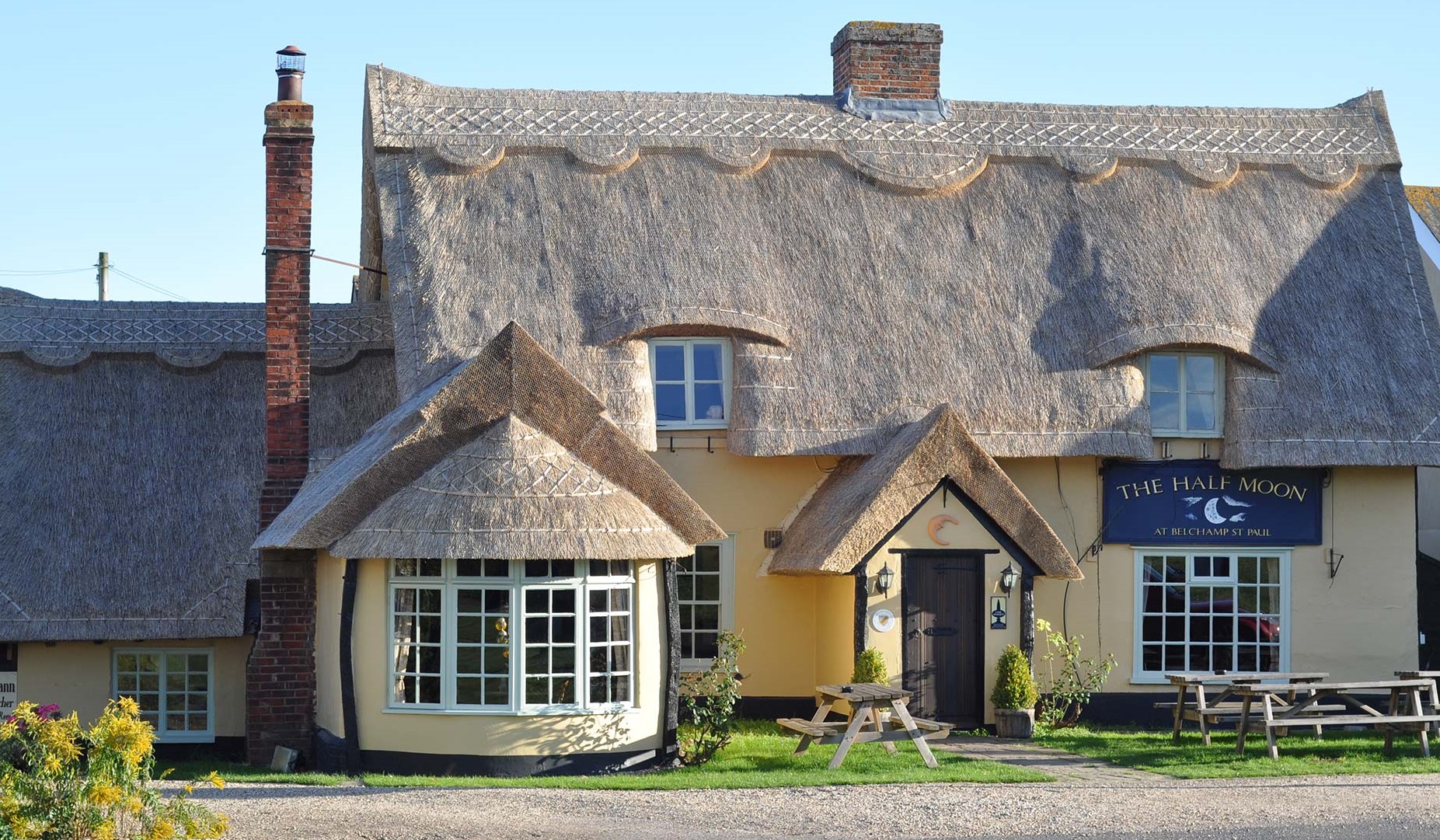Webmaster Notes
This page was visited 2 Oct 2025 10 Oct 2025
What makes this page be clicked when the other Belchamp Pages are not?
I could be due to a photo of the Half Moon pub
The Belchamps - Essex/Suffolk
The Belchamps are a collection of villages on the Suffolk Essex border.
The villages are:
There is supposedly a 4th, Belchamp St. Ethelburt, this is one of
Beresford's lost villages
and is thought to have been located between Belchamp Otten and Belchamp St. Paul's.
Top
More Research
The information that I had found of Belchamp St. Paul's had a reference to ESAH (Essex Society for Archaeology
& History). Initially I was frustrated that the references that were quoted on the history of the village that was originally posted on the Belchamp Walter Village Hall wesite did not cite the references.
Digging deeper into the information on ESAH I found a list of documents that relate the research by Reaney, P., Place-names of Essex, Cambridge 1935; and Kemble, J., Essex Place-names, Places, Streets & People,
Historical Publications, London 2007.
Also included in the ESAH files for the Essex villages (Places) are title maps for the areas. The Tithe Map for
Belchamp Walter is dated 1847. I have downloaded and scanned these files and extracted the relevant information.
ESAH - Tithe Award - 1847
The Essex Society for Archaeology & History website has a listing: "Essex Parish Place-name books" (see link below).
The Entry for Belchamp Walter is transcribed below:
Belchamp Walter Parish (Hinckford Hundred).
Belchamp Walter Tithe Award (Essex Record Office D/CT 26a), dated 1847, shows a rent-charge of £834-19-0,
for Great Tithes £26
to John Baker, £2-10-0 to Thomas Chinnery, £7-7-0 to Timothy Raymond, £54-1-10 to
Samuel Milbank Raymond,
for Glebe 8s5d to S.M. Raymond and 8s5d to the Vicar,
for Small Tithes £194-8-8 to the Vicar of Belchamp Walter and to the Rector of Belchamp Otton 8s.
The total acreage of the parish was 2129 acres 2 roods 9 perches of which 2125a Ir 26p were subject to tithes.
1764a Or 13p were arable, 290a 2r 15p meadow, 13a Or 33p wood 45a Or 9p common, waste and roads, 7a 3r 18p cottages,
8a 3r Ip water and la Or Op globe. The Tithe Commissioners were J.W Buller and Richard Jones.
Assistant Commissioners Thomas James Tatham of Bedford Place, Russell Square, London and William Wakeford Attree.
The Valuer was Robert Franklin.
The Tithe Map (D/CT 26b), dated 1847, was surveyed at a scale of 26.6 inches to a mile, measures 98" x 51" and was
signed by
William Wakeford Attree. Bylcham is documented in c. 970 and c. 998. Both refer to Belchamp St. Pauls.
Belhcham is documented in the Will of Leofgifu, lay patroness of a cell at St. Neots, Huntingdonshire,
dated 1035x1044,
who granted the estate, except the land of the steward Godric, to my lady (Whitelock, 1930). Hart (1971,1992)
identifies this as Belchamp Walter.
In Domesday Book, Belcham was held by Bernard from Count Eustace which Ednoth, a free man, held as a manor before
1066, for hide and 10 acres. In 1473, this was united as the chapelry of Allbrights into Ovington
(see "The Tithe Place-names of Ovington", ERO, 2003).
In the Half-Hundred of Thunreslau, Thunderlow (subsequently included into Hinckford), Belcamp was held by
Aubrey de Vere, which Wulfin held before 1066 as a manor for 21⁄2 hides, with an attachment of 11⁄2 hides and 15 acres of which Enisam held 1⁄2 hide and 30 acres from Aubrey, William Peche 1⁄2 hide and Suadus 30 acres.
The lost Half-Hundred of Thunreslau which included part of
Belchamp Walter and Ballingdon extended across the River Stour. Its moot was in the parish of Bulmer near
Goldingham Hall
(Christy, 1926). Reaney (1935) attributes byle to the name of the ridge or hill along which the parishes of
Belchamp are distributed,
with early confusion with French beauchamp. Ekwall (1960) offers Old English balca, a beam (in the roof of a
local prominent building
perhaps). The suffix was -ham(m), settlement, enclosure or watermeadow (?referring to Belchamp Brook).
Belchamp Walter was also
Great, Cuntasse (from the Countess of Oxford), Simonis (from Simon de Beauchamp (t. Stephen, 1135-1154),
and Willelmi
(from his son). Walter de Teye held Waterbelcham in 1297.
The reference to Walter de Tey from a Tithe Map dated 1847 may not be correct. However, this seems to have
perpertuated itself as a fact in later histories.
There were three manors:
1. Belchamp Walter Hall - near the west end of the church belonged to the de Vere family until the
17th century. Aubrey de Vere was Chamberlain of England t. Henry I (1100-1135). His daughter Roese married
Geoffrey de Mandeville.
2. Mary Hall in 1270 this manor belonged to John Mandut and later to Thomas de Ufford, Earl of Suffolk.
In 1442 it was the
property of William Pannell (cp Pannell's Ash).
3. Easton Hall - William le Gros Earl of Albermarle's grandson was Ranulf de Eston 1. Richard II (1377-1399).
Later the manor belonged to the John de Vere, the 5th earl, 1. Edward III (1340-1360) (Morant, 1768).
References
These need to be scanned from downloaded document - Below is an image:
The entry for Water Belchampe is attributed to M.ii.229 - which I am assuming is
Morant's Vol 2 page 229

